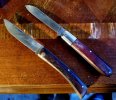Hey there!
So I was browsing an old antique store by my house today, and I saw this in a case. It was cheap, so I grabbed it! The only markings are "ROSTFREI" on the blade which I learned means rust free? in German. Does anyone have any insight as to the age of this knife? I am not a big collector, and I didn't buy it hoping to have found something valuable, I just really liked the simplicity of it, and I like vintage/antique items. Now I apologize if this is a question for another section, but I was also wondering if cleaning it up in one piece is the right method, or if taking it apart and straightening some of the liners and also cleaning internally is a better route. I would just hate to ruin the scales. The blade has a solid lock up, but does have side to side wiggle. The blade also needs some tlc. Any info from anyone with more experience than me would be greatly appreciated. Thanks in advance!





So I was browsing an old antique store by my house today, and I saw this in a case. It was cheap, so I grabbed it! The only markings are "ROSTFREI" on the blade which I learned means rust free? in German. Does anyone have any insight as to the age of this knife? I am not a big collector, and I didn't buy it hoping to have found something valuable, I just really liked the simplicity of it, and I like vintage/antique items. Now I apologize if this is a question for another section, but I was also wondering if cleaning it up in one piece is the right method, or if taking it apart and straightening some of the liners and also cleaning internally is a better route. I would just hate to ruin the scales. The blade has a solid lock up, but does have side to side wiggle. The blade also needs some tlc. Any info from anyone with more experience than me would be greatly appreciated. Thanks in advance!







